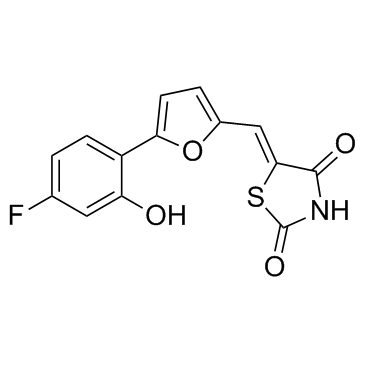900515-16-4
| Name | 5-[[5-(4-Fluoro-2-hydroxyphenyl)-2-furanyl]methylene]-2,4-thiazolidinedione |
|---|---|
| Synonyms |
2,4-Thiazolidinedione, 5-[[5-(4-fluoro-2-hydroxyphenyl)-2-furanyl]methylene]-, (5Z)-
(5Z)-5-{[5-(4-Fluoro-2-hydroxyphenyl)-2-furyl]methylene}-1,3-thiazolidine-2,4-dione (5Z)-5-{[5-(4-fluoro-2-hydroxyphenyl)furan-2-yl]methylidene}-1,3-thiazolidine-2,4-dione AS-252424 |
| Description | AS-252424 is a potent and selective PI3Kγ inhibitor with an IC50 of 30±10 nM. |
|---|---|
| Related Catalog | |
| Target |
PI3Kγ:30 nM (IC50) PI3Kα:935 nM (IC50) PI3Kδ:20 μM (IC50) PI3Kβ:20 μM (IC50) |
| In Vitro | AS-252424 also inhibits PI3Kα, PI3Kβ and PI3Kδ with IC50s of 935±150 nM, 20 μM and 20 μM, respectively. AS-252424 inhibits MCP-1-mediated chemotaxis in wild-type primary monocytes in a concentration-dependent manner with an IC50 value of 52 μM, as well as in the monocytic cell line THP-1 with an IC50 value of 53 μM. In the human monocytic cell line THP-1, MCP-1 binding to the GPCR chemokine receptor CCR2, strongly induces phosphorylation of PKB/Akt, which is effectively inhibited by AS-252424 at IC50 values as low as 0.4 μM. In contrast, induction of PKB/Akt phosphorylation by colony stimulating factor (CSF-1), binding to the growth factor receptor c-fms, is only blocked by AS-252424 at IC50 values as high as 4.7 μM[1]. |
| In Vivo | Oral administration of AS-252424 in a mouse model of acute peritonitis leads to a significant reduction of leukocyte recruitment. To evaluate the efficacy of AS-252424 to block leukocyte migration in vivo, it is tested in a mouse model of thioglycollate-induced peritonitis. Oral administration of AS-252424 at 10 mg/kg results in moderate reduction of neutrophil recruitment (35%±14%), almost matching the result observed in PI3Kγ-deficient mice. Given the short oral half-life of AS-252424 (t1/2=1 h) and relative high clearance (2.25 L/kg per h), investigations at later time points (24-48 h) to assess macrophage and monoycyte recruitment are not undertaken. The modest pharmacokinetic properties do not appear to be caused by rapid oxidative metabolism (microsomal metabolism after 1 h: 16% (rat), 10% (human))[1]. |
| Kinase Assay | A PI3Kγ lipid kinase assay, based on the neomycin-coated scintillation proximity assay (SPA) bead technology, is performed in 384-well plates using ATP/[γ33P]ATP and PtdIns. Kinase assays for IC50 value determinations with PI3Kα, PI3Kβ, and PI3Kδ are carried out[1]. |
| Cell Assay | After 3 h of starvation in serum-free medium, Raw-264 macrophages are pretreated with inhibitors (e.g., AS-252424, 1 nM, 10 nM, 100 nM, 1 μM, 10 μM and 100 μM) or DMSO for 30 min and stimulated for 5 min with 50 nM C5a. PKB/Akt phosphorylation is monitored using phospho-Ser-473 Akt specific antibody and standard ELISA protocols[1]. |
| Animal Admin | Mice[1] PI3Kγ knockout (KO) mice are used. Oral administration of AS-252424 at 10 mg/kg is performed in PI3Kγ-deficient mice. |
| References |
| Density | 1.6±0.1 g/cm3 |
|---|---|
| Molecular Formula | C14H8FNO4S |
| Molecular Weight | 305.281 |
| Exact Mass | 305.015808 |
| PSA | 104.84000 |
| LogP | 2.14 |
| Appearance | yellow |
| Index of Refraction | 1.692 |
| Storage condition | 2-8°C |
| Water Solubility | DMSO: >20mg/mL |
| Personal Protective Equipment | Eyeshields;Gloves;type N95 (US);type P1 (EN143) respirator filter |
|---|---|
| RIDADR | NONH for all modes of transport |
